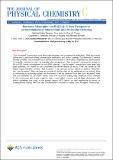Files in this item
Benzene adsorption on Rh(111) : a new perspective on intermolecular interactions and molecular ordering
Item metadata
| dc.contributor.author | Treanor, Michael-John | |
| dc.contributor.author | Garrido Torres, Jose Antonio | |
| dc.contributor.author | Bromley, Catherine J. | |
| dc.contributor.author | Fruchtl, Herbert A | |
| dc.contributor.author | Schaub, Renald | |
| dc.date.accessioned | 2019-05-06T23:37:25Z | |
| dc.date.available | 2019-05-06T23:37:25Z | |
| dc.date.issued | 2018-06-07 | |
| dc.identifier | 253076556 | |
| dc.identifier | e7263eff-4e0a-4884-a232-34c00519ce8a | |
| dc.identifier | 85046767739 | |
| dc.identifier | 000435020300032 | |
| dc.identifier.citation | Treanor , M-J , Garrido Torres , J A , Bromley , C J , Fruchtl , H A & Schaub , R 2018 , ' Benzene adsorption on Rh(111) : a new perspective on intermolecular interactions and molecular ordering ' , Journal of Physical Chemistry C , vol. 122 , no. 22 , pp. 11890-11904 . https://doi.org/10.1021/acs.jpcc.8b02798 | en |
| dc.identifier.issn | 1932-7447 | |
| dc.identifier.other | RIS: urn:02A2A7C0A9B07C6D9310464BF4223EE2 | |
| dc.identifier.other | ORCID: /0000-0001-6647-4266/work/60887502 | |
| dc.identifier.uri | https://hdl.handle.net/10023/17651 | |
| dc.description | The authors acknowledge financial support from the Scottish Funding Council (through EaStCHEM and SRD-Grant HR07003) and from EPSRC (PhD studentships for JAGT − EP/M506631/1, and MJT − EP/K503162/1). | en |
| dc.description.abstract | The adsorption of benzene on the Rh(111) substrate was investigated through scanning tunneling microscopy (STM) imaging and density functional theory (DFT) calculations. Experiments were carried out at various surface coverages, with the amount of benzene adsorbed determined to influence the molecular adsorption site, the intermolecular interactions, and the interaction between the molecule and the substrate. At a sub-monolayer coverage of the surface, the molecules are disordered and kept apart by a strong inter-adsorbate repulsion, with a preference for the molecule to adsorb on a three-fold hcp hollow site. At high coverage, the preferred adsorption site becomes the two-fold symmetric bridge site, whether as part of the two dense ordered structures that form at high coverage ((2√3×3)rect or (√19×√19)R23.4°) or as part of the disordered array of benzene molecules, which are arranged in formations which resemble the “building blocks” of the ordered overlayers. Despite the adsorption energy for benzene within both dense structures being similar, the (√19×√19)R23.4° overlayer is only observed if the substrate is annealed to 363 K during or after deposition, indicating that the formation of the (√19×√19)R23.4° ordering is inhibited by an activation barrier at lower temperatures and can only be overcome by increasing the temperature of the Rh(111) support. | |
| dc.format.extent | 2355989 | |
| dc.language.iso | eng | |
| dc.relation.ispartof | Journal of Physical Chemistry C | en |
| dc.subject | QD Chemistry | en |
| dc.subject | DAS | en |
| dc.subject.lcc | QD | en |
| dc.title | Benzene adsorption on Rh(111) : a new perspective on intermolecular interactions and molecular ordering | en |
| dc.type | Journal article | en |
| dc.contributor.sponsor | Scottish Funding Council | en |
| dc.contributor.institution | University of St Andrews. School of Chemistry | en |
| dc.contributor.institution | University of St Andrews. EaSTCHEM | en |
| dc.identifier.doi | 10.1021/acs.jpcc.8b02798 | |
| dc.description.status | Peer reviewed | en |
| dc.date.embargoedUntil | 2019-05-07 | |
| dc.identifier.grantnumber | SCISS HR07003 | en |
This item appears in the following Collection(s)
Items in the St Andrews Research Repository are protected by copyright, with all rights reserved, unless otherwise indicated.

